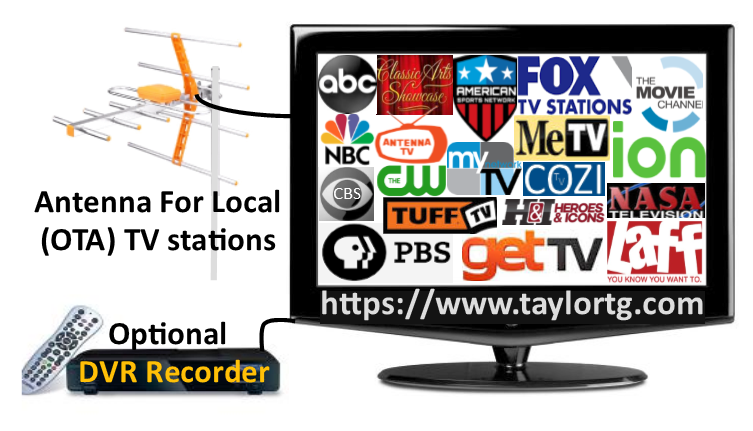
|
TV Setup - Local TV using an antenna |
|---|
|
If you have a VHF physical channel (7 through 13) in your area, do not purchase any antenna
unless the box specifies that it is designed to capture both VHF and UHF
bands, and the store has a decent return policy.
There is no such thing as a digital TV antenna or a HD TV antenna. The antenna on top of the homes of your parents and grandparents would work just fine today. An antenna collects broadcast transmissions that are sent on a frequency where the antenna radials were cut to match that frequency. The antenna does not peek at the signal. It just passes the electrons on to whatever is at the other end of the coax cable. In our case it will be your TV set. The TV set has the job of putting all the pieces back together to make a picture with sound.
Assuming the antenna was designed properly, an antenna with more radials will provide a stronger TV signal than an antenna with fewer than four. This will be noticeable when the TV towers are farther away, the terrain is hilly, tall buildings are littered between your TV and the broadcast towers, or the sky is cluttered with rain or snow. For this reason, I find that towers located further than forty miles from your TV set might experience additional screen dropout (pixilation) occasionally that would be uncomfortable to watch without a good antenna.
If using an indoor TV antenna, the acceptable TV viewing range would likely be less than a twenty-mile tower range during rainstorms and more. TV antennas do not like to be indoors. The UHF (14 - 51) frequencies TV signals travel on, do not easily penetrate metal, wood, or other dense objects. Try and keep the front of your antenna as far away from an object as you can.
Outside on the ground, the antenna will
work best when placed on a pole where the bottom of the antenna is at
least three feet from the ground or the length of the longest radial if
over three feet, and the pole is mounted in an open area away from
bushes and trees. If you just must be technical about this, all
antennas should be aimed upwards at a forty-five-degree angle.
Sometimes a seemingly perfect antenna location is far away from the TV set(s). The best location is on top the home, or in a clear area on the same side of the house as most of the TV broadcast towers in your city.
However
there is an exception to this rule. All coax cables produce some signal loss. The
longer the cable run, the weaker the signal to the TV. Try to make the
coax cable run less than one-hundred feet. While we can compensate for
long runs with a pre-amplifier on the antenna, it would be great if you
do not have to add components that may cause maintenance down the road.
When purchasing an antenna, take note if the antenna is amplified. Try
to avoid amplified antennas if possible; However, it is not always possible, depending upon your
location. What you are looking for in the advertisement and on
the box, is the signal capture distance for the antenna without an
amplifier. Often a built-in antenna amplifier cannot be removed from the
circuit. So, when the amplifier loses power or dies, so does your
antenna. If needed, you can always add a good amplifier later to
an antenna that does not have one built in.
Avoid antennas where the coax is permanently connected to the antenna.
Mostly likely the cable is not long enough and adding additional cable
adds additional connectors. Each connector in the coax line
decreases signal strength; Not to mention that when you change antennas,
you will also have to rerun a new coax line at least part way.
TaylorTG.com
|